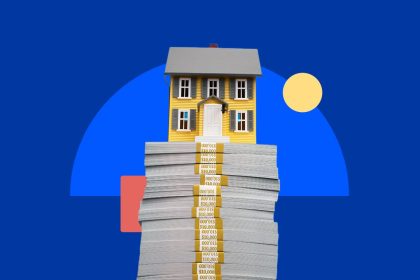Key takeaways
- Using rewards credit cards strategically during a recession can help you offset expenses via cash back rewards and possibly save you money through access to card-specific perks.
- Now is a good time to do an audit of your credit card portfolio to ensure you have the right mix to get you through a recession.
- Credit cards can provide a degree of financial flexibility in case your income is disrupted in a recession, but it’s important to use them wisely and limit the balances you carry to avoid unnecessary interest charges.
Many consumers are feeling the pinch of record high prices on goods and services. While inflation fell from 2.9 percent in April 2024 to 2.3 percent a year later, according to USAFacts, it doesn’t mean consumers aren’t still worried about it rising again.
Given these and other financial pressures — like a possible recession — it’s no surprise that 75 percent of Americans in Bankrate’s 2024 Financial Freedom Survey say they are not completely financially secure — or that 30 percent of those people expect that they’ll never feel financially secure.
The odds of the U.S. economy entering a recession by March 2026 have risen to 36 percent, up from a low of 26 percent in the fourth quarter of 2024, according to Bankrate’s latest Economic Indicator Survey.
All this considered, it’s smart to start taking action now. That might mean cutting back on your spending, boosting your emergency fund or reassessing your retirement savings. But it might also include identifying ways to incorporate credit cards into your recession survival strategy.
Used wisely, credit cards can offer easy access to a line of credit when you need it most, offset your expenses through cash back rewards and provide a variety of other money-saving perks.
How to use your credit cards in a recession
Reduce credit card debt
Nearly two in three U.S. credit cardholders who carry a balance from month to month (64 percent) say they have delayed or avoided financial decisions because of their credit card debt, according to Bankrate’s Credit Card Debt Report. As of November 2024, 48 percent of American credit cardholders carry a credit card balance from month to month.
While the percentage of debtors is almost flat compared to the most recent surveys, it’s up from the 39 percent who reported carrying a balance in a December 2021 Bankrate survey. That could mean Americans have been grappling with inflation and emergency expenses during the last three years.
To shield your finances from the impact of a recession, it’s best to pay down as much of your credit card debt as you can. If you’re not sure how to get started, our credit card payoff calculator can help you assess your debt and come up with a plan to wipe your financial slate clean.
“Debt can rob you of your future because you are using the money you earn today to pay off things from the past,” says personal finance professional Andrew Lokenauth, founder and CEO of TheFinanceNewsletter.com. “If unpaid, debt can grow larger and larger with the interest and fees adding up.”
Avoid carrying a balance if possible
Reducing your credit card debt minimizes the balances you carry — which, in turn, will reduce the amount of interest you’ll pay. With average credit card interest rates currently sitting just over 20 percent, these charges can add up.
Ideally, you should clear your balances before credit card issuers tack on any interest. Ted Rossman, Bankrate’s senior industry analyst and expert contributor, recommends paying off credit card charges every two weeks, if possible.
Unfortunately, a lot is out of our control during a recession. However, paying down credit card debt is an excellent way to take some control in a time of uncertainty. Paying down as much credit card debt today (even if you can’t pay it all) will allow you to better manage the financial and emotional uprooting of a recession.
Carrying credit card debt increases your monthly financial obligations. The stakes feel higher, particularly around keeping your job, as you must meet these obligations.
— Kate Dornan
Licensed independent clinical social worker and certified financial therapist
Lean on a card with 0 percent APR
If you have to carry a balance, a good 0 percent APR credit card can help you to temporarily avoid interest charges on purchases or balance transfers during a window of time, usually ranging from 12 months to 21 months.
One example is the BankAmericard® credit card*, which offers a 0 percent intro APR on purchases and balance transfers (made during the first 60 days) for 18 billing cycles. However, be aware that, after the intro APR period ends, you’ll be charged a 15.24% – 25.24% Variable APR on purchases and balance transfers.
Consider a balance transfer
A balance transfer credit card allows you to move your credit card debt from your existing card to a new one, typically in exchange for a 0 percent APR intro rate for a set period of time (often between 12 and 21 months).
If you can pay off your balance within this introductory period, you’ll save whatever interest charges your former card would have assessed. But be warned — it’s best to only do a balance transfer if you’re sure you can pay it off before the introductory 0 percent APR ends. Otherwise, you will save money on interest during the intro period, but you will start paying interest charges again when the intro period ends. Plus, you’ll likely have added a balance transfter fee to your debt.
Monitor your credit card use
Understandably, a recession isn’t the best time to rack up credit card charges for unnecessary expenses. Instead, pay attention to your credit card usage, focusing on using your cards as tools that help you make it through a recession.
“Credit cards can provide a financial safety net in the event you don’t have an adequate emergency savings fund,” says consumer finance expert Andrea Woroch. “This way, you can pay necessary bills or unexpected expenses, without worrying how you’re going to come up with the cash.”
Bankrate insight
To keep from running up too many charges on a credit card, think about activating account alerts that notify you when a purchase exceeds a certain amount (like $500) or the balance creeps close to a certain level (such as $5,000).
While monitoring your usage is important, it’s also a good idea to automate credit card payments so you don’t miss a due date and risk getting slapped with late fees or a penalty APR, Woroch says. After all, juggling your finances during a recession is nerve-racking enough. You don’t need to add to your stress by missing payments.
Create a budget
If you don’t already have one, Lokenauth suggests setting up a household budget to better manage your credit cards and overall finances. That said, he’s agnostic when it comes to budget program recommendations. All sorts of software, websites and apps (including Bankrate’s Home Budget Calculator) and even ChatGPT can help you create a budget that works best for you.
“Not having a budget can make it difficult to know where you are spending your money or difficult to have control over your spending in general,” says Lokenauth. “Creating a budget will help you visualize where you can cut back spending and where you can save money.”
Use rewards to counter inflation and rising interest rates
Earning rewards is one of the most valuable aspects of using credit cards. While it doesn’t make sense to carry a balance at a high APR in order to earn cash back or travel rewards, taking advantage of these benefits can offset the impact of a recession if you pay your bills on time and only charge what you must.
You may also have benefits accruing that you aren’t aware of, so be sure to check your credit cards accounts to see your current earnings. Consider using tools like AwardWallet, The Points Guy app and MaxRewards or create a spreadsheet to track the points, miles and cash back you earn on your credit cards.
Maximize cash back
To maximize the value of credit card rewards for countering inflation, start by making sure you have one of the best cash back cards in your wallet — and that you understand the benefits of each card you have. To squeeze the most you can out of cash back rewards, determine which ones to pull out of your wallet for different circumstances.
For example, imagine you have three cards: a credit card with 2 percent cash rewards on purchases, one that earns 3 percent cash back on gas and grocery purchases and another that offers 5 percent cash back on travel. Here’s how you can maximize your earning potential in this scenario:
- Flat-rate cash back card. Use this as your everyday spending card, paying for as much as you can outside of your gas, grocery and travel purchases. As an example, the Wells Fargo Active Cash® Card offers an unlimited flat rate of 2 percent cash rewards on purchases.
- Gas and grocery card. Rather than putting your gas and grocery purchases onto your 2 percent cash back card, pull out a card that offers enhanced benefits on common spending categories. The Blue Cash Preferred® Card from American Express, for example, earns 6 percent cash back on U.S. supermarket purchases (up to $6,000 per year, then 1 percent) and 3 percent cash back at U.S. gas stations.
- Travel card. Finally, if you’re going to be traveling, make sure you have access to a card that earns maximum rewards for this type of spending. The [capi_name card_name=”Capital One Savor Cash Rewards Credit Card” pid=”221012282″d delivers 8 percent cash back on Capital One Entertainment purchases, 5 percent cash back on hotels and rental cars booked using Capital One Travel and unlimited 3 percent cash back on dining, entertainment, popular streaming subscriptions and grocery store purchases (excluding superstores like Walmart and Target).
Take advantage of credit card perks
While maximizing your rewards can be lucrative, the perks your credit cards give can be just as valuable, if not more so, than the rewards they provide. For instance, your card might qualify for purchase protections, extended warranties or roadside assistance.
You may be able to score discounts on meals, car rentals, household services or clothing from special card issuer deals like Amex Offers or Visa Offers. Or you can use shopping portals, like Shop Through Chase or Southwest Rapid Rewards Shopping, to accumulate points and miles.
Ask for help when you need it
If you’re struggling with your finances, don’t be afraid to seek help. There are options that fit almost any situation:
- Financial counseling. Sign up with a nonprofit credit counseling agency to help you climb out of your credit card debt hole.
- Debt consolidation loan. Use a loan, a balance transfer credit card or a debt management program to cover what you owe.
- Debt settlement. Your card issuer may either agree to let you pay off part of your debt in exchange for forgiving the rest of it or allow you to pay part of the debt, then use a payment plan to cover the balance owed. But know that you could face damage to your credit score, IRS taxes and the risk of falling deeper into debt if you don’t make payments.
- Bankruptcy. Chapter 7 forces you to sell off available assets, give the proceeds to creditors and any remaining unsecured debt is typically discharged. Chapter 13 lets you create a three- to five-year repayment plan while allowing you to keep your assets. But be warned — this option should only be used as a last resort, since your credit will be wrecked for 10 years under Chapter 7 and seven years under Chapter 13.
The bottom line
J.P. Morgan Research raised the probability of a recession occurring in 2025 to 60 percent, up from 40 percent, according to a report released on April 15, 2025. “The U.S. policy mix appears to be shifting further, perhaps unintentionally, from supporting the current expansion,” writes Bruce Kasman, chief global economist at J.P. Morgan.
Fortunately, you may be able to ease some of your recession fears by wisely incorporating credit cards into your everyday finances. During rocky financial times, credit cards can smooth things out by enabling you to cover emergency expenses, earn rewards on everyday spending and access money-saving perks.
*Information about the BankAmericard® credit card was updated on May 26, 2025. Information about the BankAmericard® credit card has been collected independently by Bankrate.com. The card details have not been reviewed or approved by the card issuer.
Read the full article here
















